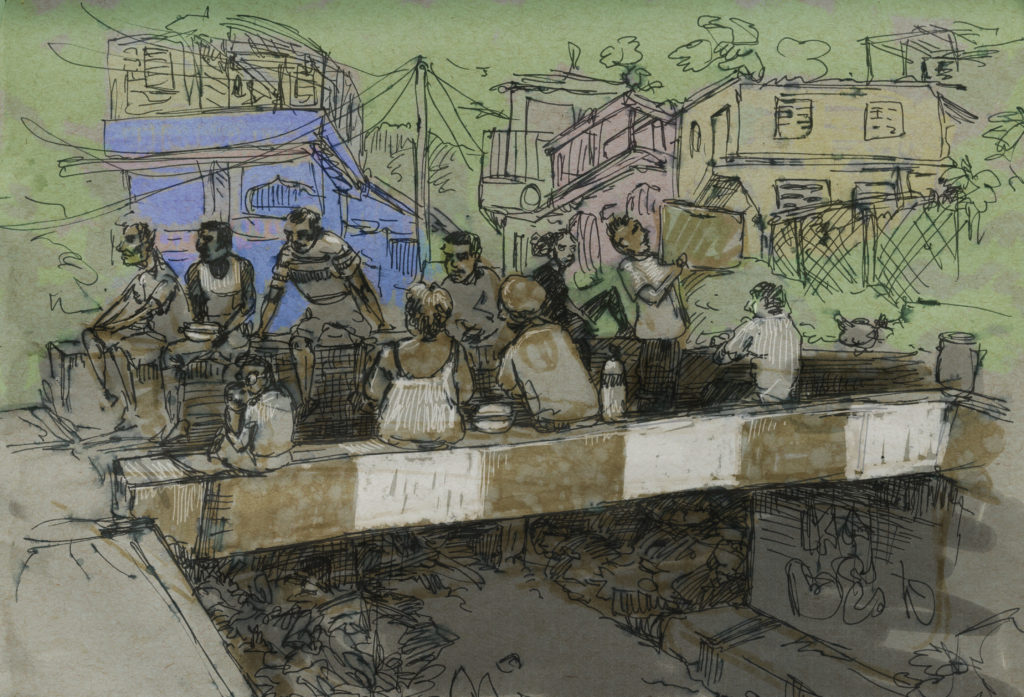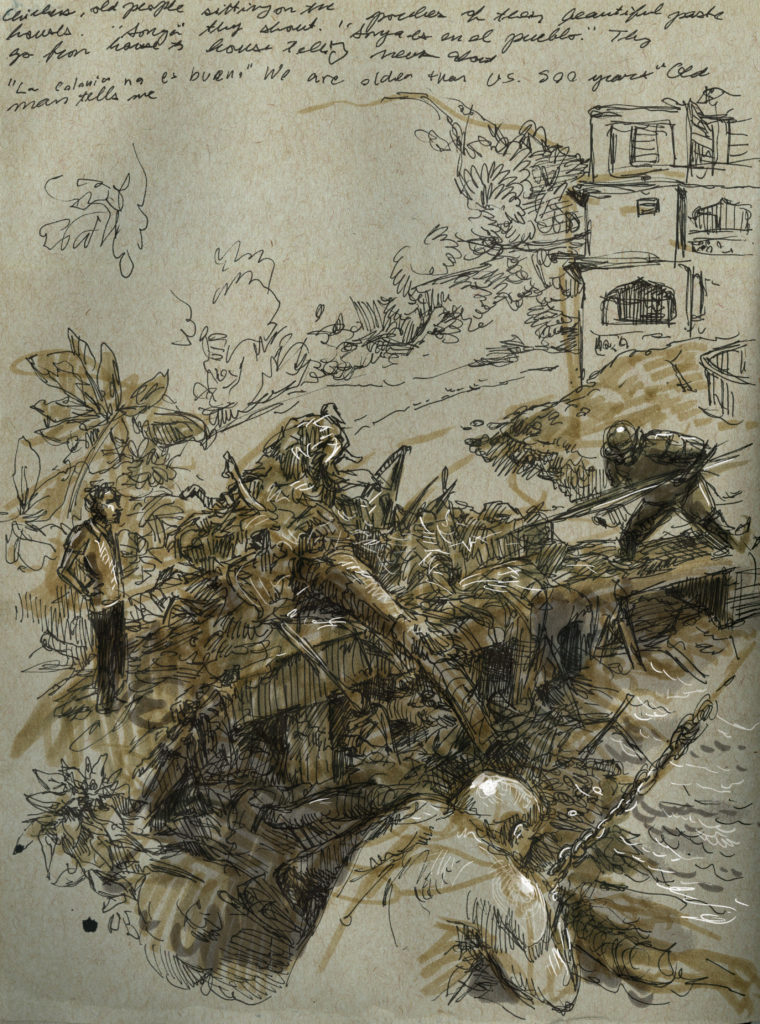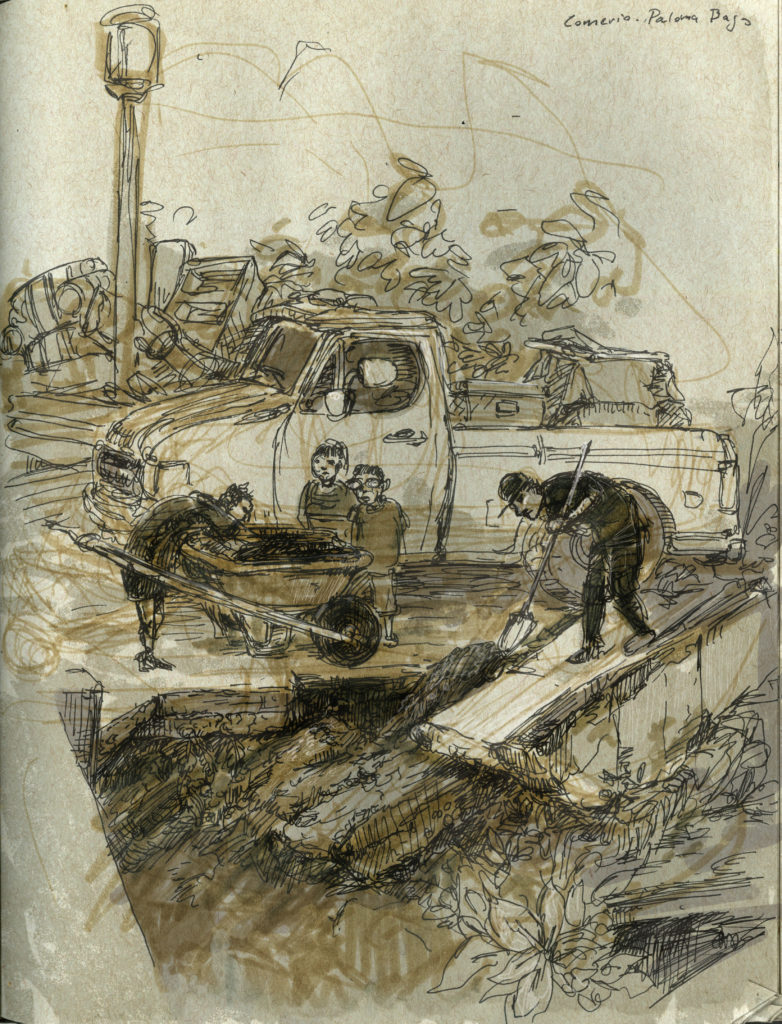【eroticism (2015), vimeo】
Puerto Rico Sketchbook: The eroticism (2015), vimeoArtists with the Shovels
Look
In November, the artist and writer Molly Crabapple spent a week in Puerto Rico documenting grassroots efforts by communities to rebuild after Hurricane Maria. Here are excerpts from her sketchbook.

Molly Crabapple, Bridge, 2017.
Eli Jacobs-Fantauzzi has lost track of how many times he’s been to Barrio Paloma Abajo since the hurricane hit. As he drove up the vertiginous roads of the Cordillera Central, he ticked off what he and his colleagues at Defend PR have accomplished so far. They were working with an architect to rebuild houses wrecked by Maria. They brought seeds and water filters and set up a solar-powered cinema. Solar lights, mosquito nets, batteries, bug spray, rat traps. They drove kids to a local comedy show. They installed tarps on roofs and brought chain saws to cut down the dangling tree branches and shoveled debris from the broken bridge. They organized themselves into brigades to clean wrecked farms. Jacobs-Fantauzzi rolled up his sleeve and showed me a trail of red welts. Ants, he suspected.
Jacobs-Fantauzzi is a filmmaker, not an aid worker. Defend PR, the media collective he cofounded, had been known for its documentary shorts, not for delivering hundreds of meals, as they planned to that day. His carmates were the circus performer Lizaimi Rivera Rivera and the artist Edgardo Larregui Rodriguez, who created Coco de Oro, the community organization that works with Defend PR in the barrio. Yet these artists had done something that neither Puerto Rico’s neglectful colonial overlords nor its governor had bothered to try. After the hurricane hit, they loaded their cars with donations from Defend PR and the Puerto Rican diaspora and drove into the mountains, determined to find out what people needed.

PALOMA ABAJO CLEANUP, 2017.
During one of their early trips to the Comerió municipality, they found Barrio Paloma Abajo. “We were driving by and saw a group of people in front of two flags with the message, DON’T ASK WHAT P.R. CAN DO FOR YOU, BUT WHAT YOU CAN DO FOR P.R.” Jacobs-Fantauzzi told me. “We stopped and met Cuca, the owner of the house. She introduced us to Tete, a thirteen-year-old with an amazing haircut. Tete jumped on his bike and took us all around Paloma Abajo. When we talked to people, they told us stories about what they’d lost, who’d lost their houses, who’d lost their roofs, who was bedridden, and who needed the most help … The community is so kind. They make us food and coffee and treat us like family. The kids meet us at the bridge to the community, with hugs, ready to work. The community started organizing itself, and we felt the need to keep encouraging that and helping however we could. That’s the story, that’s why we keep coming back.”
Paloma Abajo is a cascade of houses hanging from the mountainside—tiny, cheap, constructed by the neighborhood’s working-class residents, but each is a palace, if one could measure that by the panache of their arches, the brio of the fleurdelisé fences that border the balconies, their lace ironwork, their walls colored like blueberries or salt-water taffy or crème de menthe. Water and electricity had already been erratic in the barrio since May, but two months after Maria, it was nonexistent, save for a single, mocking streetlight. Blue tarp stretched over many homes, makeshift covering for missing roofs. The tarps were not from FEMA, an old man stressed, though the military had set up headquarters a short drive away. They did, however, have piles of MREs.

Shovels, 2017.
I sketched the Defend PR crew as they spent the day digging and hauling alongside residents, and then as they helped hand out the two hundred hot meals donated by a San Juan chef.
“Our colonial government, the USA, and our local government have failed the people at a time when they needed the most help,” Jacobs-Fantauzzi told me later. “Everywhere I look, I see Puerto Ricans helping each other. We are the answer to our own problems and collectively we can create a just transition where we have a good relationship with our land and with each other.”
Molly Crabapple is an artist and author of the memoir Drawing Blood. Her next book, Brothers of the Gun, cowritten with the Syrian war journalist Marwan Hisham, will be published by Random House in May 2018.
Search
Categories
Popular Posts
Best free online courses from MIT
2025-06-27 00:44MacBook Air reviews: 4 features critics loved, 4 they didn’t
2025-06-27 00:26EV sales up 30 percent this year despite Tesla woes
2025-06-26 23:54The Ideal Smartphone for 2017
2025-06-26 23:54Featured Posts
Brest vs. PSG 2025 livestream: Watch Champions League for free
2025-06-27 02:34Sniffies launches official iOS app
2025-06-27 01:26MacBook Air reviews: 4 features critics loved, 4 they didn’t
2025-06-27 00:50We'll always, er, sorta, have the Paris Climate Agreement
2025-06-27 00:19Popular Articles
Trump who? Tech giants join massive effort to uphold Paris Agreement
2025-06-27 02:29MacBook Air reviews: 4 features critics loved, 4 they didn’t
2025-06-27 02:23New NC bill would ban minors from social media
2025-06-27 01:53Google cracks down on Chrome extensions following Honey scandal
2025-06-27 00:32Then and Now: 5 Generations of GeForce Graphics Compared
2025-06-27 00:00Newsletter
Subscribe to our newsletter for the latest updates.
Comments (31634)
Exploration Information Network
Best AirPods deal: Apple AirPods 4 for $99.99 at Amazon
2025-06-27 02:19Information Information Network
NYT mini crossword answers for March 8, 2025
2025-06-27 01:39Habit Information Network
Today's Hurdle hints and answers for March 12, 2025
2025-06-27 01:12Creative Information Network
'The Last of Us' Season 2 trailer: Hidden details you may have missed
2025-06-27 00:39Shocking Information Network
Trump says he represents Pittsburgh, not Paris, but, um, well...
2025-06-27 00:05